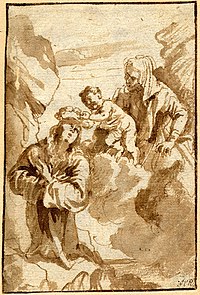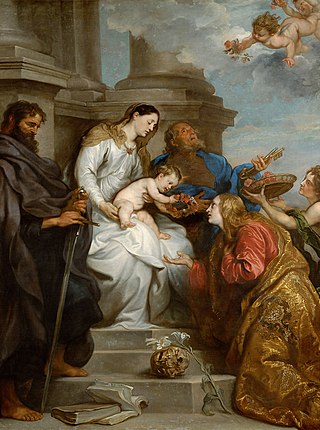
Rosalia, nicknamed la Santuzza, is the patron saint of Palermo in Italy, Camargo in Chihuahua, and three towns in Venezuela: El Hatillo, Zuata, and El Playón. She is especially important internationally as a saint invoked in times of plague. From 2020 onwards she has been invoked by some citizens of Palermo to protect the city from COVID-19.
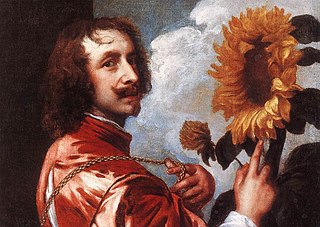
Sir Anthony van Dyck was a Flemish Baroque artist who became the leading court painter in England after success in the Spanish Netherlands and Italy.
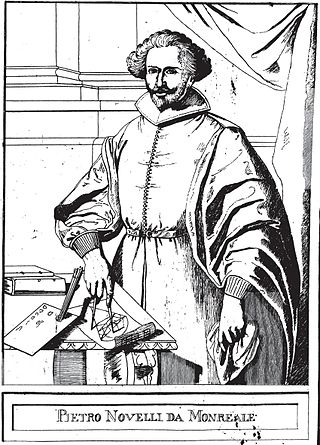
Pietro Novelli was an Italian painter of the Baroque period, active mainly in Palermo. Also known as il Monrealese or Pietro "Malta" Novelli to distinguish him from his father, Pietro Antonio Novelli I. He was also nicknamed by contemporaries as the Raphael of Sicily.
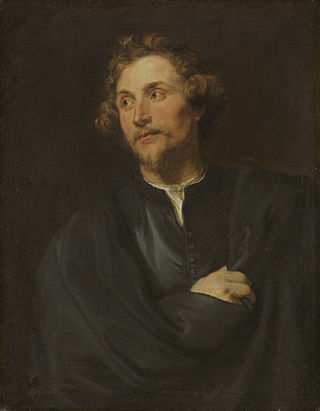
Georg Petel was a German sculptor and a virtuoso ivory carver. His work marks the beginning of Baroque sculpture in Germany.

Sir Peter Paul Rubens was a Flemish artist and diplomat from the Duchy of Brabant in the Southern Netherlands. He is considered the most influential artist of the Flemish Baroque tradition. Rubens's highly charged compositions reference erudite aspects of classical and Christian history. His unique and immensely popular Baroque style emphasized movement, colour, and sensuality, which followed the immediate, dramatic artistic style promoted in the Counter-Reformation. Rubens was a painter producing altarpieces, portraits, landscapes, and history paintings of mythological and allegorical subjects. He was also a prolific designer of cartoons for the Flemish tapestry workshops and of frontispieces for the publishers in Antwerp.
Jan Baptist de Wael or Jan Baptist de Wael the Younger was a Flemish painter and printmaker, who was principally active in Italy.

The Vision of the Blessed Hermann Joseph or The Mystical Engagement of the Blessed Hermann Joseph to the Virgin Mary is a 1629-1630 painting by the Flemish Baroque painter Anthony van Dyck.

Madonna and Child is a 1621–1627 painting by Anthony van Dyck, now in the Galleria nazionale di Parma.

Saint Rosalie Interceding for the Plague-stricken of Palermo is a painting of 1624 by Anthony van Dyck, in the Metropolitan Museum of Art in New York since 1871.
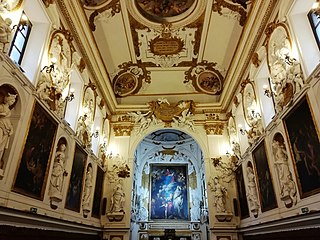
The Oratory of the Rosary of Saint Dominic is a Baroque oratory of Palermo. It is located near the Church of Saint Dominic, in the quarter of the Loggia, within the historic centre of Palermo.

Geronimo Gerardi (1595-1648) was a Flemish artist active in Italy. He was born Guilliam Walsgart or Hyeronimus Gerards.
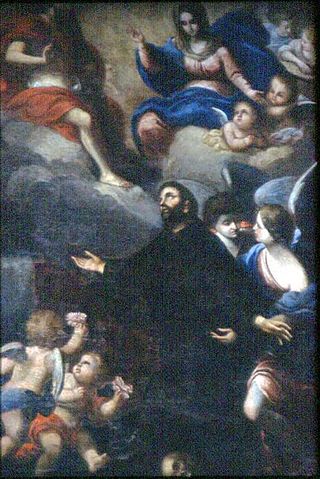
Andrea Carrera or Carreca was an Italian Baroque painter mainly active in Sicily. He was born in Trapani and died in Palermo.

Saint Rosalia Crowned by Angels is an oil on canvas painting by the studio of Anthony van Dyck, created c. 1624, one of several works showing the saint produced whilst van Dyck was quarantined in Palermo, Sicily due to a plague. It is now in the Galleria Regionale del Palazzo Abatellis in Palermo, where in 2015 it was displayed alongside Saint Rosalie Interceding, loaned from the Metropolitan Museum of Art.

Saint Rosalia Crowned by Angels is a c. 1625 oil on canvas painting by Anthony van Dyck, one of five surviving works showing the saint which he produced whilst he was quarantined in Palermo, Sicily due to a plague. It is now in the Menil Collection in Houston, Texas, which bought it in 1968. It was loaned from there in 2011-2012 to the Dulwich Picture Gallery in London.
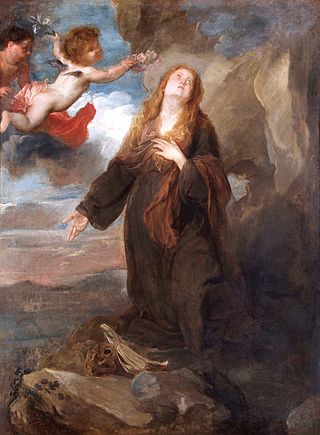
Saint Rosalia Crowned by Angels is a c. 1625 oil on canvas painting by Anthony van Dyck, one of five surviving works showing the saint which he produced whilst he was quarantined in Palermo, Sicily due to a plague. It is now in the Wellington Collection at Apsley House in London.

Saint Rosalia is a c.1625 oil on canvas painting by Anthony van Dyck. Originally owned by Giovan Francesco Serra di Cassano, it was bought by Philip IV of Spain via his Viceroy of Naples Gaspar de Bracamonte in 1664 and is now in the Museo del Prado in Madrid

Saint Rosalia Interceding for the City of Palermo is an oil on canvas painting of Saint Rosalia by Anthony van Dyck, now in the Museo de Arte de Ponce in Puerto Rico, which acquired it at auction at Sotheby's in London on 7 December 1960. It is sometimes dated to 1629 when the artist was back in Antwerp and sometimes to 1624-1625 whilst the artist was quarantined in Palermo, Sicily.

The Virgin Presenting Saint Rosalia to the Trinity is an oil on canvas painting, now in the Alte Pinakothek in Munich. Its poor condition makes attribution difficult, but it is usually attributed to Anthony van Dyck in his Sicilian period (1624-1625)
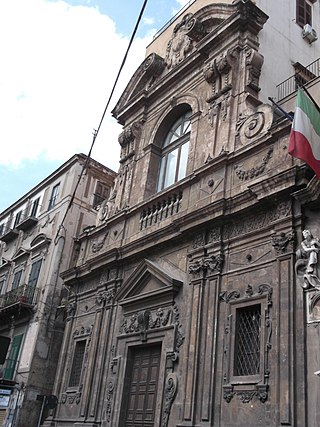
The Biblioteca centrale della Regione Siciliana is an historic library located on Via Vittorio Emanuele # 429 in central Palermo, region of Sicily, Italy.

The Sanctuary of Santa Rosalia is a church and pilgrimage site located on via Bonnaojust outside of the urban neighborhoods of Palermo, nestled against a stone cliff wall on Mount Pellegrino, which looms to the north of the Sicily city. On 15 July 1624, putative relics of this 12th century saint were discovered in a cave at the site, and since the plague ebbed after these bones were paraded through town, Saint Rosalia was adopted as the fourth female patron saint of Palermo, and this sanctuary was erected in her honor.



